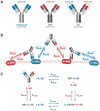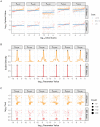This is a preprint.
Mechanistic computational modeling of monospecific and bispecific antibodies targeting interleukin-6/8 receptors
- PMID: 38187701
- PMCID: PMC10769311
- DOI: 10.1101/2023.12.18.570445
Mechanistic computational modeling of monospecific and bispecific antibodies targeting interleukin-6/8 receptors
Update in
-
Mechanistic computational modeling of monospecific and bispecific antibodies targeting interleukin-6/8 receptors.PLoS Comput Biol. 2024 Jun 7;20(6):e1012157. doi: 10.1371/journal.pcbi.1012157. eCollection 2024 Jun. PLoS Comput Biol. 2024. PMID: 38848446 Free PMC article.
Abstract
The spread of cancer from organ to organ (metastasis) is responsible for the vast majority of cancer deaths; however, most current anti-cancer drugs are designed to arrest or reverse tumor growth without directly addressing disease spread. It was recently discovered that tumor cell-secreted interleukin-6 (IL-6) and interleukin-8 (IL-8) synergize to enhance cancer metastasis in a cell-density dependent manner, and blockade of the IL-6 and IL-8 receptors (IL-6R and IL-8R) with a novel bispecific antibody, BS1, significantly reduced metastatic burden in multiple preclinical mouse models of cancer. Bispecific antibodies (BsAbs), which combine two different antigen-binding sites into one molecule, are a promising modality for drug development due to their enhanced avidity and dual targeting effects. However, while BsAbs have tremendous therapeutic potential, elucidating the mechanisms underlying their binding and inhibition will be critical for maximizing the efficacy of new BsAb treatments. Here, we describe a quantitative, computational model of the BS1 BsAb, exhibiting how modeling multivalent binding provides key insights into antibody affinity and avidity effects and can guide therapeutic design. We present detailed simulations of the monovalent and bivalent binding interactions between different antibody constructs and the IL-6 and IL-8 receptors to establish how antibody properties and system conditions impact the formation of binary (antibody-receptor) and ternary (receptor-antibody-receptor) complexes. Model results demonstrate how the balance of these complex types drives receptor inhibition, providing important and generalizable predictions for effective therapeutic design.
Figures








References
-
- Hodge DR, Hurt EM, Farrar WL. The role of IL-6 and STAT3 in inflammation and cancer. European Journal of Cancer. 2005. Nov;41(16):2502–12. - PubMed
-
- Hong DS, Angelo LS, Kurzrock R. Interleukin-6 and its receptor in cancer. Cancer. 2007. Nov;110(9):1911–28. - PubMed
-
- Hoch RC, Schraufstätter IU, Cochrane CG. In vivo, in vitro, and molecular aspects of interleukin-8 and the interleukin-8 receptors. Journal of Laboratory and Clinical Medicine. 1996. Aug;128(2):134–45. - PubMed
-
- Petersen F, Flad HD, Brandt E. Neutrophil-activating peptides NAP-2 and IL-8 bind to the same sites on neutrophils but interact in different ways. Discrepancies in binding affinities, receptor densities, and biologic effects. Journal of Immunology [Internet]. 1994. Mar;152(5):2467–78. Available from: https://www.jimmunol.org/content/152/5/2467.short - PubMed
-
- Chuntharapai A, Kim KJ. Regulation of the expression of IL-8 receptor A/B by IL-8: possible functions of each receptor. Journal of Immunology [Internet]. 1995. Sep;155(5):2587–94. Available from: https://www.jimmunol.org/content/155/5/2587.short - PubMed
Publication types
Grants and funding
LinkOut - more resources
Full Text Sources
Research Materials
